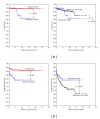Prognosis of multifocal papillary thyroid carcinoma
- PMID: 24489543
- PMCID: PMC3892555
- DOI: 10.1155/2013/809382
Prognosis of multifocal papillary thyroid carcinoma
Abstract
This study was to investigate the clinical features and therapeutic outcomes of multifocal papillary thyroid microcarcinoma (PTMC). A total of 2,418 papillary thyroid carcinoma (PTC) patients had undergone thyroidectomy in one medical center between 1977 and 2010. There were 483 (20.0%) diagnosed with multifocal PTC. The percentage of multifocal PTC was higher in PTMC patients (22.0%) than in non-PTMC patients (19.5%). Demographic and clinical characteristics of PTMC and multifocal PTC in PTC patients were traced. Multifocal PTC patients presented with smaller tumors at an older age, and a higher percentage underwent total or complete thyroidectomy. These patients also showed a higher incidence of postoperative disease progression than did unifocal PTC patients. Comparison of 483 patients with multifocal PTMC and non-PTMC tumors showed a higher incidence of postoperative disease progression in patients with non-PTMC; otherwise, there was no statistical difference in disease-specific and total mortality between these two groups. In conclusion, the incidence of multifocal PTMC was not lower than that of non-PTMC, and postoperative therapies were necessary for both multifocal PTMC and non-PTMC patients.
Figures
Similar articles
-
Significance of multifocality in papillary thyroid carcinoma.Eur J Surg Oncol. 2020 Oct;46(10 Pt A):1820-1828. doi: 10.1016/j.ejso.2020.06.015. Epub 2020 Jun 19. Eur J Surg Oncol. 2020. PMID: 32732090
-
Therapeutic Outcomes of Patients with Multifocal Papillary Thyroid Microcarcinomas and Larger Tumors.Int J Endocrinol. 2017;2017:4208178. doi: 10.1155/2017/4208178. Epub 2017 May 31. Int J Endocrinol. 2017. PMID: 28642790 Free PMC article.
-
Comparison of clinicopathological features and prognosis of papillary thyroid carcinoma and microcarcinoma: A population-based propensity score matching analysis.Front Endocrinol (Lausanne). 2022 Aug 5;13:944758. doi: 10.3389/fendo.2022.944758. eCollection 2022. Front Endocrinol (Lausanne). 2022. PMID: 35992148 Free PMC article.
-
Mortality rate and causes of death in papillary thyroid microcarcinoma.Endocrine. 2024 Mar;83(3):671-680. doi: 10.1007/s12020-023-03510-8. Epub 2023 Oct 9. Endocrine. 2024. PMID: 37814113 Review.
-
Papillary thyroid microcarcinoma: how to diagnose and manage this epidemic?Int J Surg Pathol. 2014 Apr;22(2):113-9. doi: 10.1177/1066896913517394. Epub 2014 Jan 7. Int J Surg Pathol. 2014. PMID: 24401191 Review.
Cited by
-
The Impact of Total Tumor Diameter on Lymph Node Metastasis and Tumor Recurrence in Papillary Thyroid Carcinomas.Diagnostics (Basel). 2024 Jan 26;14(3):272. doi: 10.3390/diagnostics14030272. Diagnostics (Basel). 2024. PMID: 38337788 Free PMC article.
-
[Current controversies in risk-adapted therapy in differentiated thyroid cancer: Is less (therapy) really more?].Wien Med Wochenschr. 2020 Feb;170(1-2):15-25. doi: 10.1007/s10354-019-00713-5. Epub 2019 Dec 3. Wien Med Wochenschr. 2020. PMID: 31797245 German.
-
Outcomes of nonsuspicious contralateral nodules with active surveillance after lobectomy in patients with papillary thyroid carcinoma.Front Endocrinol (Lausanne). 2022 Jul 15;13:941080. doi: 10.3389/fendo.2022.941080. eCollection 2022. Front Endocrinol (Lausanne). 2022. PMID: 35909520 Free PMC article.
-
Association of multifocality, tumor number, and total tumor diameter with clinicopathological features in papillary thyroid cancer.Endocrine. 2016 Sep;53(3):774-83. doi: 10.1007/s12020-016-0955-0. Epub 2016 Apr 18. Endocrine. 2016. PMID: 27090526
-
CLINICALLY UNDETECTABLE OCCULT THYROID PAPILLARY CARCINOMA PRESENTING WITH CERVICAL LYMPH NODE METASTASIS.Acta Endocrinol (Buchar). 2016 Jan-Mar;12(1):72-76. doi: 10.4183/aeb.2016.72. Acta Endocrinol (Buchar). 2016. PMID: 31258804 Free PMC article.
References
-
- Cramer JD, Fu P, Harth KC, Margevicius S, Wilhelm SM. Analysis of the rising incidence of thyroid cancer using the Surveillance, Epidemiology and End Results national cancer data registry. Surgery. 2010;148(6):1147–1152. - PubMed
-
- Londero SC, Krogdahl A, Bastholt L, et al. Papillary thyroid carcinoma in Denmark 1996–2008: an investigation of changes in incidence. Cancer Epidemiology. 2013;37(1):e1–e6. - PubMed
-
- Kuo S-F, Chao T-C, Chang H-Y, Hsueh C, Yang C-H, Lin J-D. Prognostic evaluation of patients with multicentric papillary thyroid microcarcinoma. Journal of the Formosan Medical Association. 2011;110(8):511–517. - PubMed
-
- Ivanova R, Soares P, Castro P, Sobrinho-Simões M. Diffuse (or multinodular) follicular variant of papillary thyroid carcinoma: a clinicopathologic and immunohistochemical analysis of ten cases of an aggressive form of differentiated thyroid carcinoma. Virchows Archiv. 2002;440(4):418–424. - PubMed
-
- Giannini R, Ugolini C, Lupi C, et al. The heterogeneous distribution of BRAF mutation supports the independent clonal origin of distinct tumor foci in multifocal papillary thyroid carcinoma. The Journal of Clinical Endocrinology and Metabolism. 2007;92(9):3511–3516. - PubMed
LinkOut - more resources
Full Text Sources
Other Literature Sources



